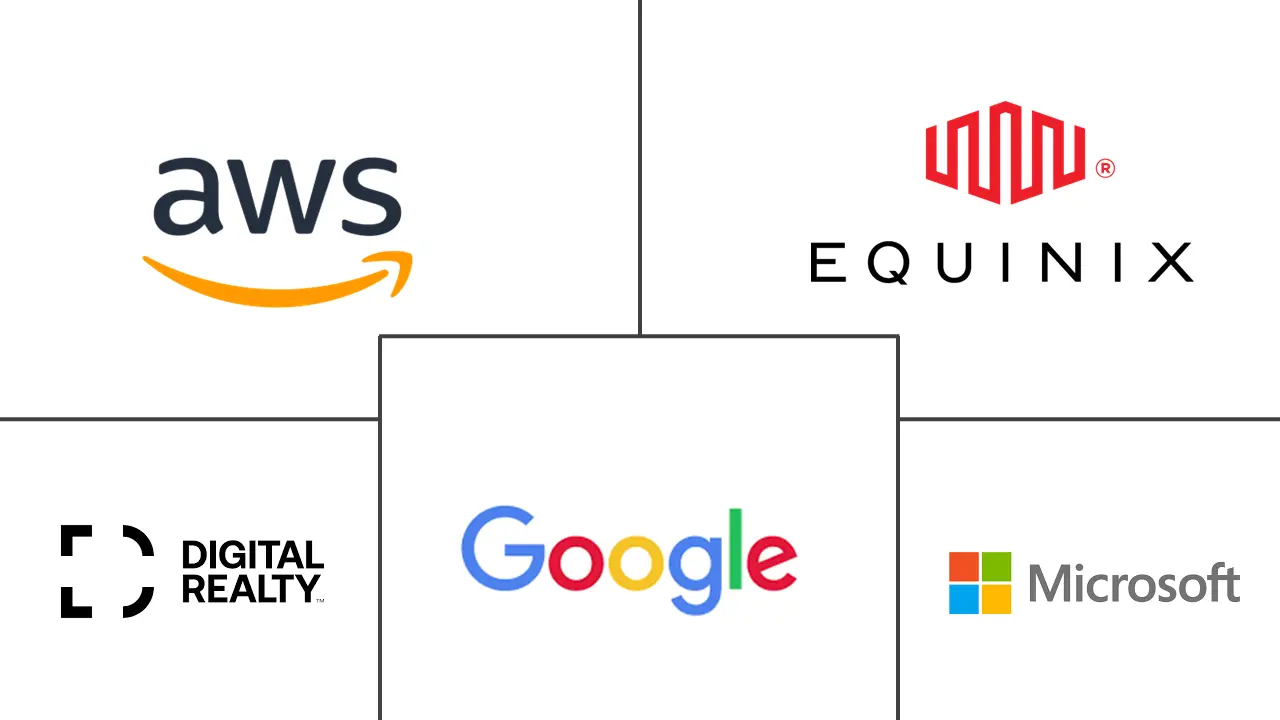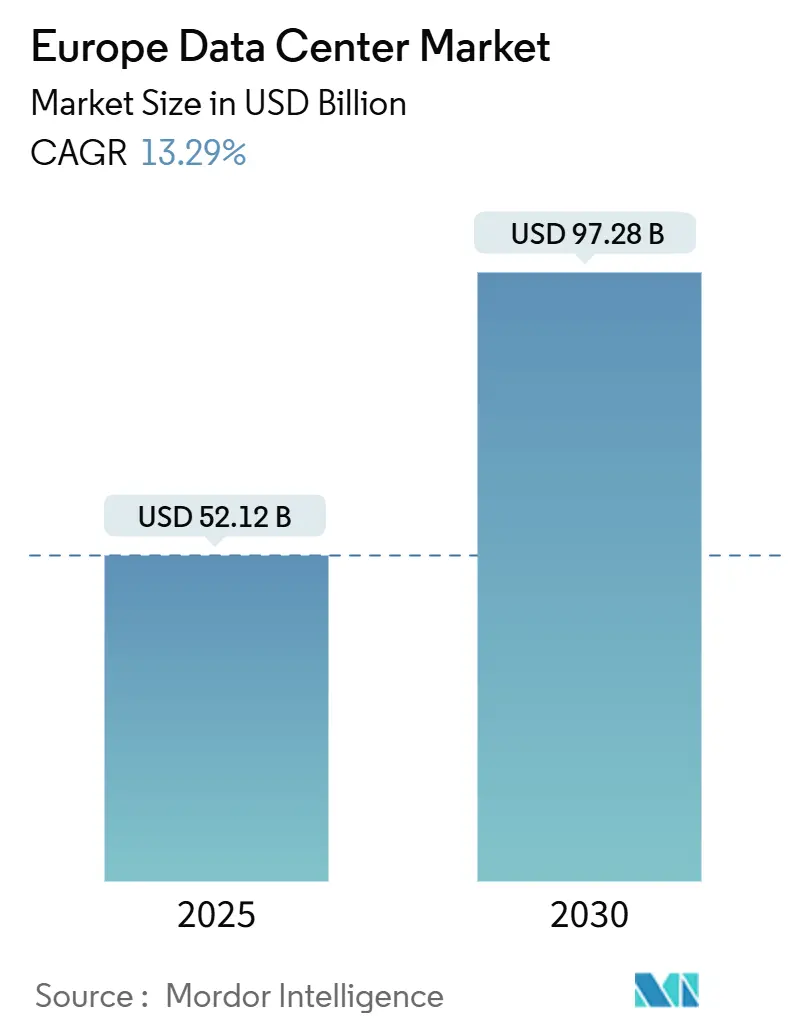
Europe Data Center Market Analysis by Mordor Intelligence
The Europe Data Center Market size is estimated at USD 52.12 billion in 2025, and is expected to reach USD 97.28 billion by 2030, at a CAGR of 13.29% during the forecast period (2025-2030). In terms of the installed base, the market is expected to grow from 23.93 thousand megawatts in 2025 to 54.71 thousand megawatts by 2030, at a CAGR of 17.98% during the forecast period (2025-2030). The market segment shares and estimates are calculated and reported in terms of MW. Rapid scale-out by hyperscale cloud providers, accelerated 5G deployments, and strict regional data-sovereignty regulations collectively fuel capacity additions across both primary and secondary hubs. Intensifying edge computing requirements compel operators to distribute micro-facilities near end-users, while renewable energy power purchase agreements (PPAs) increasingly influence total cost of ownership decisions. Grid congestion in Frankfurt, London, Amsterdam, Paris, and Dublin (FLAP-D) prompts developers to scout less-crowded locales, and the interplay between carbon-reduction mandates and campus-level power procurement now defines competitive advantage. Persistent demand from banking, financial services, and insurance (BFSI) clients, as well as telecom operators, underscores the market’s resilience across macroeconomic cycles.
Key Report Takeaways
- By data center size, large facilities held 38.4% of Europe data center market share in 2024; massive deployments are forecast to expand at an 18.89% CAGR through 2030.
- By tier type, Tier 3 infrastructure commanded 61.08% share of the Europe data center market size in 2024, whereas Tier 4 is projected to grow fastest at an 18.39% CAGR.
- By data center type, colocation services accounted for 63.52% of the Europe data center market size in 2024, while hyperscale self-built facilities record the strongest 19.89% CAGR.
- By end user, IT and telecom represented 55.74% of Europe data center market share in 2024; the BFSI segment is advancing at an 18.59% CAGR to 2030.
- By geography, Germany led with 15.18% Europe data center market share in 2024, whereas the United Kingdom is set to post a 20.23% CAGR through 2030.
Europe Data Center Market Trends and Insights
Drivers Impact Analysis
| Driver | (~) % Impact on CAGR Forecast | Geographic Relevance | Impact Timeline |
|---|---|---|---|
| Surging hyperscale cloud investment across FLAP-D | +3.20% | Germany, United Kingdom, Netherlands, France | Medium term (2-4 years) |
| Accelerated 5G rollouts driving edge demand | +2.80% | Urban Europe | Short term (≤2 years) |
| Data-sovereignty regulations such as GAIA-X | +2.10% | Core EU, Switzerland, Norway | Long term (≥4 years) |
| Renewable energy PPAs lowering TCO | +1.90% | Nordics, Spain, Germany | Medium term (2-4 years) |
| Submarine cable expansion into secondary hubs | +1.60% | Mediterranean, Baltic coastlines | Long term (≥4 years) |
| Nordic tax incentives for modular builds | +1.40% | Sweden, Norway, Denmark, Finland | Short term (≤2 years) |
| Source: Mordor Intelligence | |||
Surging Hyperscale Cloud Investment Across FLAP-D Markets
Record capital commitments by Amazon Web Services, Microsoft, and Google underscore a deep pipeline of hyperscale capacity additions. Aws earmarked EUR 8.8 billion (USD 10.24 billion) for Frankfurt expansions through 2026, while Microsoft is injecting USD 3.2 billion into Swedish cloud infrastructure to serve Northern Europe[1] Amazon Web Services, “AWS Announces €8.8 Billion Investment in Germany,” aws.amazon.com. Google’s EUR 1 billion Finnish build-out highlights a shift toward colder climates with abundant renewables. These projects emphasize artificial-intelligence workloads that demand higher power densities and liquid-cooling systems. European operators such as Data4 respond with multibillion-euro campus plans that feature 100 MW+ blocks and on-site substations. Collectively, these investments compress build timelines, elevate land prices near major peering exchanges, and accelerate competitive differentiation based on sustainability metrics.
Accelerated 5G Rollouts Driving Edge Data Center Demand
Telecom carriers rolling out private 5G services push compute resources closer to factories, hospitals, and city centers to achieve sub-10 millisecond latency. Nokia reports a sharp uptick in micro-facility tenders located within 20 kilometers of manufacturing clusters as Industry 4.0 transitions from pilot to production [2]Nokia, “Private 5G Networks Drive Edge Demand,” nokia.com. BSO’s EUR 100 million (USD 116.36 million) DataOne site in London, purpose-built for high-frequency trading, exemplifies this distributed strategy. Edge nodes also anchor content-delivery and autonomous-vehicle testbeds, broadening the customer mix for regional colocation providers. Spectrum authorities fast-track 5G allocations for private enterprise networks, accelerating procurement cycles. Resulting traffic localization amplifies demand for hardened space and power outside traditional core hubs.
Data Sovereignty Regulations Such as GAIA-X Pushing In-Region Storage
The GAIA-X initiative compels European enterprises to retain full operational control over data-processing locales and interfaces [3]GAIA-X, “Federated Cloud Infrastructure Framework,” gaia-x.eu. Banks and insurers move mission-critical workloads into EU-governed regions to meet supervisory guidelines and client expectations. OVHcloud leverages its European roots to win contracts that stipulate non-extraterritorial jurisdiction. Sovereignty requirements extend beyond physical location to include credential management, audit access, and encryption-key residency, raising the bar for compliance audits. As national governments roll out mandatory domestic hosting for sensitive sectors, a protected revenue stream emerges for providers able to document end-to-end European oversight.
Rapid Build-Out of Renewable Energy PPAs Lowering TCO
Long-dated PPAs with wind and solar producers in Spain and the Nordics mitigate electricity price volatility while slashing Scope 2 emissions. Spain’s abundance of utility-scale solar assets has yielded some of the lowest unit costs for new megawatts dedicated to data center consumption [4].Spanish Wind Energy Association, “Renewables and Data Centers,” aeeolica.org Nordic hydro and on-shore wind offer nearly carbon-free baseload, aligning with EU taxonomy rules that steer institutional capital toward green assets. Microsoft’s Swedish wind farm-backed data centers illustrate vertically integrated power sourcing models. Intelligent workload-scheduling platforms now shift compute to regions with immediate renewable oversupply, further enhancing energy-cost arbitrage opportunities. Together, these factors compress operating margins for fossil-fuel-reliant facilities and redirect new builds toward green-power clusters.
Restraints Impact Analysis
| Restraint | (~) % Impact on CAGR Forecast | Geographic Relevance | Impact Timeline |
|---|---|---|---|
| Grid congestion and power availability limitations | -1.8% | Frankfurt, London, Amsterdam, Dublin | Short term (≤2 years) |
| Extended permitting timelines amid environmental pushback | -1.2% | Germany, Netherlands, United Kingdom suburbs | Medium term (2-4 years) |
| High-voltage equipment bottlenecks (HV transformers and switchgear) leading to delayed energization | -0.9% | Germany, Ireland, Nordics; CEE hubs (Poland, Czechia) | Short–medium term (1–3 years) |
| Cooling water availability and sustainability restrictions (drought, discharge limits) raising capex/ops complexity | -0.7% | Spain, Portugal, Italy, Southern France | Medium–long term (2–5 years) |
| Source: Mordor Intelligence | |||
Grid Congestion and Power Availability Constraints in Tier-I Markets
Power-distribution bottlenecks in FLAP-D arise as existing substations near capacity, triggering moratoria on new megawatt connections in Amsterdam and Dublin [5].Amsterdam Municipality, “Data Center Development Moratorium,” amsterdam.nl National Grid ESO notes that London requires multi-billion-euro uprates by 2027 to support projected hyperscale loads. Consequently, operators pivot to secondary metros or conceive sub-50 MW modular deployments distributed across multiple grid-nodes. Investors factor in 3-to-5-year lead times for network reinforcements, reshaping return-on-capital expectations. Some hyperscalers lock in dedicated generation assets, such as gas peakers paired with battery storage, to bypass utility queues, albeit at higher upfront capital intensity.
Long Permitting Timelines Due to Environmental Opposition
Community activism and stringent environmental reviews extend project cycles across densely populated regions. German federal guidelines require full lifecycle impact analyses that add 18-to-24 months to traditional schedules. The Netherlands enforces spatial-planning caps that prevent large concrete structures near residential zones, limiting site options around the Amsterdam metro. Objections commonly cite noise, land-use change, and heat-emission footprints. To gain approval, developers incorporate waste-heat reuse into district-heating grids and offer community-benefit funds. While these steps build local goodwill, they increase design complexity and cost, tempering near-term capacity additions in prime corridors.
Segment Analysis
By Data Center Size: Massive Facilities Lead Growth Acceleration
Massive sites accounted for a 38.4% slice of the Europe data center market size in 2024 and are on track to outpace all other categories at an 18.89% CAGR through 2030. Enterprises continue leasing sizeable footprints inside these campuses to access hyperscale-like efficiencies without capital exposure. The Europe data center market benefits from Brookfield’s USD 10 billion Swedish artificial-intelligence hub, which illustrates investor appetite for 100 MW-plus single-building loads.
Mega campuses, some exceeding 500 MW across multiple halls, represent the next frontier. Such projects require dedicated substations and multi-gigabit fiber rings, hence cluster around heavy-industry brownfields where land is abundant. Modular design advances enable rapid expansion phases, allowing operators to defer spend until lease-up milestones trigger. Conversely, medium and small facilities cater to latency-sensitive or regulatory-restricted workloads. Although their Europe data center market share declines incrementally, they remain critical in edge rollouts and sovereign micro-cloud deployments.
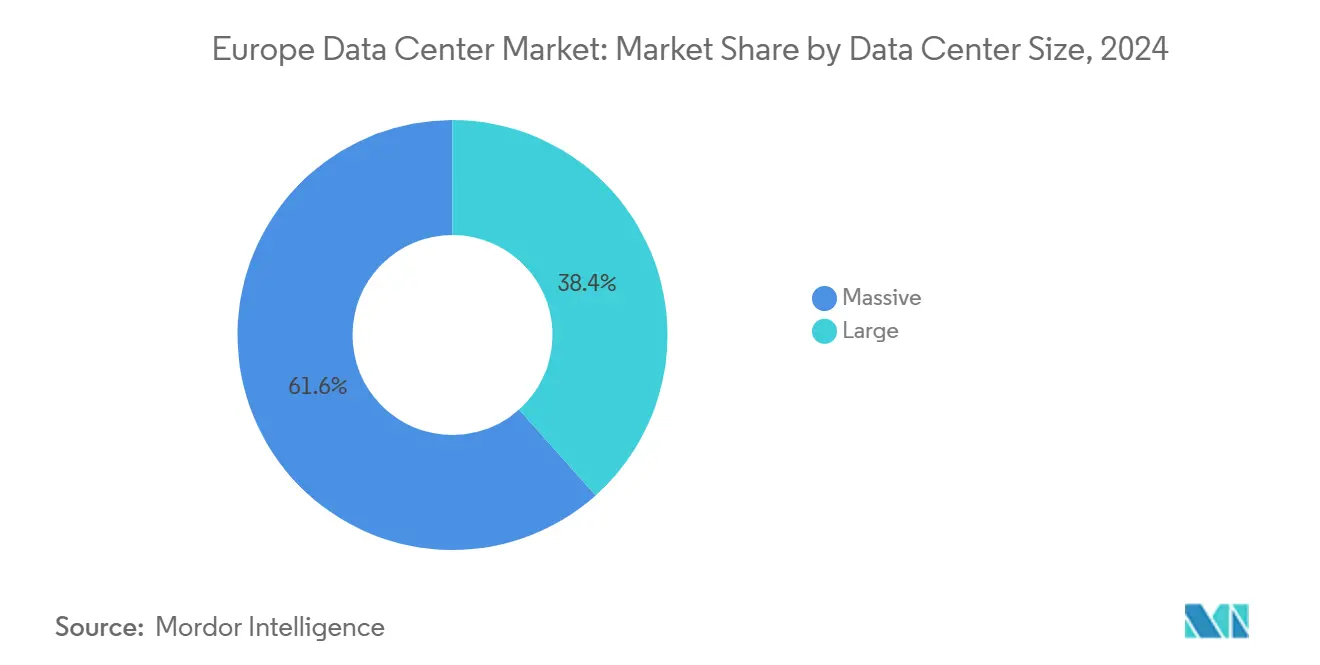
Note: Segment shares of all individual segments available upon report purchase
By Tier Type: Tier 4 Infrastructure Gains Hyperscale Traction
Tier 3 dominated with 61.08% share of the Europe data center market size in 2024, serving mainstream workloads that balance redundancy and cost. Hyperscalers, however, increasingly demand Tier 4 certifications, driving an 18.39% CAGR for the category as artificial-intelligence training and financial-transaction clearing mandate near-zero downtime.
Investments in concurrent-maintainability designs, dual power spines, and fault-tolerant cooling elevate capital intensity yet unlock premium pricing models focused on availability guarantees. Lower tiers see diminished relevance except in test or batch-processing environments. Regulatory pushes for continuous data-protection audits under GDPR further favor high-tier builds, cementing Tier 4’s ascent across both mature and emerging sub-regions.
By Data Center Type: Hyperscale Self-Built Accelerates at Premium Growth
Colocation remained supreme with 63.52% of the Europe data center market share in 2024, but self-built hyperscale assets will race ahead at a 19.89% CAGR as cloud majors crave bespoke densities and liquid-cool deployments. Custom campus blueprints allow operators to position high-usage GPUs and optical interconnects without multi-tenant design compromises.
Retail colocation still attracts small and medium enterprises transitioning from on-premises rooms, while wholesale suites accommodate regional software-as-a-service platforms pursuing dedicated cages. Edge-only facilities appear in 1–5 MW blocks and emphasize local peering rather than large floor plates. Collectively, these archetypes populate a continuum that lets customers shift between models as digital-transformation roadmaps evolve.
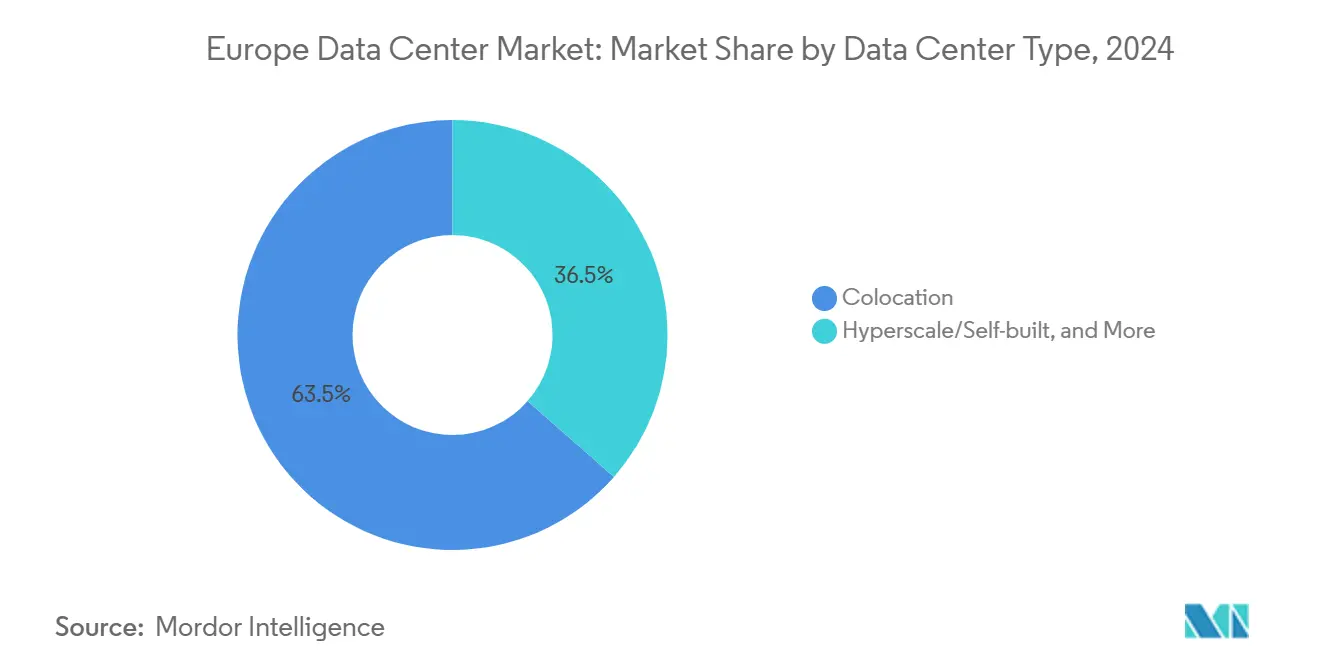
Note: Segment shares of all individual segments available upon report purchase
By End User: BFSI Sector Drives Digital Transformation Investments
IT and telecom players generated 55.74% of overall demand in 2024, powered by 5G core rollouts and network-function virtualization initiatives. The BFSI vertical, at an 18.59% CAGR, is the most aggressive adopter of high-tier infrastructure due to stringent uptime and encryption obligations.
E-commerce spikes prompt seasonal leasing of burst-capacity cages, while media companies require contiguous racks with 100 Gbps ports to stream 4K and 8K content. Manufacturing customers install edge nodes on factory grounds to govern robotic assembly lines and predictive-maintenance analytics. Governments embed security-cleared rooms inside accredited colocation sites to align with cloud-first mandates yet remain compliant with classified-data handling protocols.
Geography Analysis
Germany held a 15.18% leadership position in 2024, underpinned by Frankfurt’s role as DE-CIX’s heart and the nation’s extensive industrial-grade grid. Expansion projects, such as Data4’s multi-site investment program, proceed despite rigorous environmental reviews that stretch delivery timelines. Renewable-energy adoption, propelled by national Energiewende policies, prompts operators to blend on-site solar arrays with PPAs for hydro and offshore wind.
The United Kingdom posts the highest growth trajectory at a 20.23% CAGR, as London’s liquidity pools and Scotland’s renewable corridors converge with investor confidence following post-Brexit clarity. The United Kingdom government’s AI strategy funnels grants and tax credits toward compute-intensive R and D clusters, drawing both domestic and overseas capital. Secondary nodes in Manchester and Cardiff gain momentum as London’s grid tightens and space premiums rise.
France, the Netherlands, Spain, and Nordics each carve specific niches. France aligns with sovereignty goals by nurturing domestic providers under cybersecurity-certification schemes. Amsterdam grapples with grid moratoria yet retains its strategic magnetism through dense submarine-cable landings. Spain’s sunny climate fuels low-cost solar PPAs that lure AI and blockchain operators. Nordic states capitalize on free-cooling climates, low carbon intensity, and favorable depreciation schedules, positioning Stockholm and Oslo as preferred destinations for GPU-rich clusters.
Competitive Landscape
Competitive intensity is rising as hyperscale self-build programs remove megawatts from the retail colocation pipeline, prompting incumbents to differentiate through interconnection fabrics, managed security, and sustainability credentials. Digital Realty and Equinix leverage pan-European footprints and neutral-carrier exchanges to maintain stickiness, while OVHcloud markets its European ownership structure to sovereignty-minded clients. Regional specialists, including NorthC and AQ Compute, scale through acquisitions that knit together edge-oriented sites across Benelux and DACH regions.
Technology moats now center on immersion-cooling systems, AI-ready cage densities, and real-time carbon-tracking dashboards aligned with EU taxonomy disclosures. Strategic alliances emerge between colocation landlords and chip manufacturers to host reference clusters that shorten supply chains for cloud service rollouts. Liquid-cool retrofits spread as operators strive to support 100 kW racks without overhauling entire mechanical plants.
Private-equity inflows accelerate consolidation, with Bain Capital’s EUR 800 million (USD 930.85 million) purchase of AQ Compute illustrating appetite for cash-flow-stable yet growth-rich assets. Meanwhile, open compute-inspired designs erode proprietary hardware margins, nudging operators to monetize differentiators such as dark-fiber overlays, sovereign cloud zones, and AI model hosting platforms. Overall, competitive focus shifts from gross-area metrics to workload suitability, environmental impact, and cross-border compliance frameworks.
Europe Data Center Industry Leaders
-
Amazon Web Services, Inc.
-
Microsoft Corporation
-
Digital Realty Trust Inc.
-
Equinix, Inc.
-
Google Inc.
- *Disclaimer: Major Players sorted in no particular order
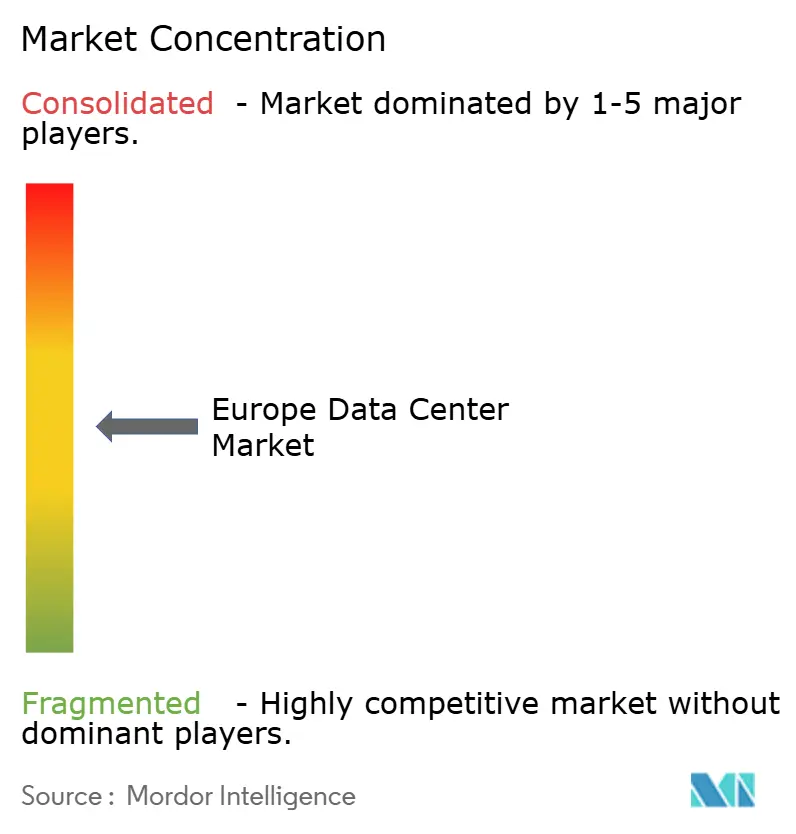
Recent Industry Developments
- January 2025: OpenAI announced partnership with Norwegian data center operators to establish Arctic infrastructure for artificial-intelligence training workloads.
- December 2024: Brookfield Asset Management committed USD 10 billion to Swedish artificial-intelligence infrastructure development.
- November 2024: Microsoft expanded its Swedish cloud infrastructure investment to USD 3.2 billion.
- October 2024: Bain Capital completed acquisition of AQ Compute for EUR 800 million (USD 930.85 million), broadening European edge reach.
- July 2024: NorthC acquired Dutch regional assets, boosting edge coverage.
Europe Data Center Market Report Scope
Large, Massive, Medium, Mega, Small are covered as segments by Data Center Size. Tier 1 and 2, Tier 3, Tier 4 are covered as segments by Tier Type. Non-Utilized, Utilized are covered as segments by Absorption. France, Germany, Ireland, Netherlands, Norway, Spain, Switzerland, United Kingdom are covered as segments by Country.| Large |
| Massive |
| Medium |
| Mega |
| Small |
| Tier 1 and 2 |
| Tier 3 |
| Tier 4 |
| Hyperscale/Self-built | ||
| Enterprise/Edge | ||
| Colocation | Non-Utilized | |
| Utilized | Retail Colocation | |
| Wholesale Colocation | ||
| BFSI |
| IT and ITES |
| E-Commerce |
| Government |
| Manufacturing |
| Media and Entertainment |
| Telecom |
| Other End Users |
| United Kingdom |
| Germany |
| France |
| Russia |
| Belgium |
| Spain |
| Norway |
| Austria |
| Netherlands |
| Italy |
| Sweden |
| Switzerland |
| Denmark |
| Rest of Europe |
| By Data Center Size | Large | ||
| Massive | |||
| Medium | |||
| Mega | |||
| Small | |||
| By Tier Type | Tier 1 and 2 | ||
| Tier 3 | |||
| Tier 4 | |||
| By Data Center Type | Hyperscale/Self-built | ||
| Enterprise/Edge | |||
| Colocation | Non-Utilized | ||
| Utilized | Retail Colocation | ||
| Wholesale Colocation | |||
| By End User | BFSI | ||
| IT and ITES | |||
| E-Commerce | |||
| Government | |||
| Manufacturing | |||
| Media and Entertainment | |||
| Telecom | |||
| Other End Users | |||
| By Country | United Kingdom | ||
| Germany | |||
| France | |||
| Russia | |||
| Belgium | |||
| Spain | |||
| Norway | |||
| Austria | |||
| Netherlands | |||
| Italy | |||
| Sweden | |||
| Switzerland | |||
| Denmark | |||
| Rest of Europe | |||
Market Definition
- IT LOAD CAPACITY - The IT load capacity or installed capacity, refers to the amount of energy consumed by servers and network equipments placed in a rack installed. It is measured in megawatt (MW).
- ABSORPTION RATE - It denotes the extend to which the data center capacity has been leased out. For instance, a 100 MW DC has leased out 75 MW, then absorption rate would be 75%. It is also referred as utilization rate and leased-out capacity.
- RAISED FLOOR SPACE - It is an elevated space build over the floor. This gap between the original floor and the elevated floor is used to accommodate wiring, cooling, and other data center equipment. This arrangement assist in having proper wiring and cooling infrastructure. It is measured in square feet (ft^2).
- DATA CENTER SIZE - Data Center Size is segmented based on the raised floor space allocated to the data center facilities. Mega DC - # of Racks must be more than 9000 or RFS (raised floor space) must be more than 225001 Sq. ft; Massive DC - # of Racks must be in between 9000 and 3001 or RFS must be in between 225000 Sq. ft and 75001 Sq. ft; Large DC - # of Racks must be in between 3000 and 801 or RFS must be in between 75000 Sq. ft and 20001 Sq. ft; Medium DC # of Racks must be in between 800 and 201 or RFS must be in between 20000 Sq. ft and 5001 Sq. ft; Small DC - # of Racks must be less than 200 or RFS must be less than 5000 Sq. ft.
- TIER TYPE - According to Uptime Institute the data centers are classified into four tiers based on the proficiencies of redundant equipment of the data center infrastructure. In this segment the data center are segmented as Tier 1,Tier 2, Tier 3 and Tier 4.
- COLOCATION TYPE - The segment is segregated into 3 categories namely Retail, Wholesale and Hyperscale Colocation service. The categorization is done based on the amount of IT load leased out to potential customers. Retail colocation service has leased capacity less than 250 kW; Wholesale colocation services has leased capacity between 251 kW and 4 MW and Hyperscale colocation services has leased capacity more than 4 MW.
- END CONSUMERS - The Data Center Market operates on a B2B basis. BFSI, Government, Cloud Operators, Media and Entertainment, E-Commerce, Telecom and Manufacturing are the major end-consumers in the market studied. The scope only includes colocation service operators catering to the increasing digitalization of the end-user industries.
| Keyword | Definition |
|---|---|
| Rack Unit | Generally referred as U or RU, it is the unit of measurement for the server unit housed in the racks in the data center. 1U is equal to 1.75 inches. |
| Rack Density | It defines the amount of power consumed by the equipment and server housed in a rack. It is measured in kilowatt (kW). This factor plays a critical role in data center design and, cooling and power planning. |
| IT Load Capacity | The IT load capacity or installed capacity, refers to the amount of energy consumed by servers and network equipment placed in a rack installed. It is measured in megawatt (MW). |
| Absorption Rate | It denotes how much of the data center capacity has been leased out. For instance, if a 100 MW DC has leased out 75 MW, then the absorption rate would be 75%. It is also referred to as utilization rate and leased-out capacity. |
| Raised Floor Space | It is an elevated space built over the floor. This gap between the original floor and the elevated floor is used to accommodate wiring, cooling, and other data center equipment. This arrangement assists in having proper wiring and cooling infrastructure. It is measured in square feet/meter. |
| Computer Room Air Conditioner (CRAC) | It is a device used to monitor and maintain the temperature, air circulation, and humidity inside the server room in the data center. |
| Aisle | It is the open space between the rows of racks. This open space is critical for maintaining the optimal temperature (20-25 °C) in the server room. There are primarily two aisles inside the server room, a hot aisle and a cold aisle. |
| Cold Aisle | It is the aisle wherein the front of the rack faces the aisle. Here, chilled air is directed into the aisle so that it can enter the front of the racks and maintain the temperature. |
| Hot Aisle | It is the aisle where the back of the racks faces the aisle. Here, the heat dissipated from the equipment’s in the rack is directed to the outlet vent of the CRAC. |
| Critical Load | It includes the servers and other computer equipment whose uptime is critical for data center operation. |
| Power Usage Effectiveness (PUE) | It is a metric which defines the efficiency of a data center. It is calculated by: (𝑇𝑜𝑡𝑎𝑙 𝐷𝑎𝑡𝑎 𝐶𝑒𝑛𝑡𝑒𝑟 𝐸𝑛𝑒𝑟𝑔𝑦 𝐶𝑜𝑛𝑠𝑢𝑚𝑝𝑡𝑖𝑜𝑛)/(𝑇𝑜𝑡𝑎𝑙 𝐼𝑇 𝐸𝑞𝑢𝑖𝑝𝑚𝑒𝑛𝑡 𝐸𝑛𝑒𝑟𝑔𝑦 𝐶𝑜𝑛𝑠𝑢𝑚𝑝𝑡𝑖𝑜𝑛). Further, a data center with a PUE of 1.2-1.5 is considered highly efficient, whereas, a data center with a PUE >2 is considered highly inefficient. |
| Redundancy | It is defined as a system design wherein additional component (UPS, generators, CRAC) is added so that in case of power outage, equipment failure, the IT equipment should not be affected. |
| Uninterruptible Power Supply (UPS) | It is a device that is connected in series with the utility power supply, storing energy in batteries such that the supply from UPS is continuous to IT equipment even during utility power is snapped. The UPS primarily supports the IT equipment only. |
| Generators | Just like UPS, generators are placed in the data center to ensure an uninterrupted power supply, avoiding downtime. Data center facilities have diesel generators and commonly, 48-hour diesel is stored in the facility to prevent disruption. |
| N | It denotes the tools and equipment required for a data center to function at full load. Only "N" indicates that there is no backup to the equipment in the event of any failure. |
| N+1 | Referred to as 'Need plus one', it denotes the additional equipment setup available to avoid downtime in case of failure. A data center is considered N+1 when there is one additional unit for every 4 components. For instance, if a data center has 4 UPS systems, then for to achieve N+1, an additional UPS system would be required. |
| 2N | It refers to fully redundant design wherein two independent power distribution system is deployed. Therefore, in the event of a complete failure of one distribution system, the other system will still supply power to the data center. |
| In-Row Cooling | It is the cooling design system installed between racks in a row where it draws warm air from the hot aisle and supplies cool air to the cold aisle, thereby maintaining the temperature. |
| Tier 1 | Tier classification determines the preparedness of a data center facility to sustain data center operation. A data center is classified as Tier 1 data center when it has a non-redundant (N) power component (UPS, generators), cooling components, and power distribution system (from utility power grids). The Tier 1 data center has an uptime of 99.67% and an annual downtime of <28.8 hours. |
| Tier 2 | A data center is classified as Tier 2 data center when it has a redundant power and cooling components (N+1) and a single non-redundant distribution system. Redundant components include extra generators, UPS, chillers, heat rejection equipment, and fuel tanks. The Tier 2 data center has an uptime of 99.74% and an annual downtime of <22 hours. |
| Tier 3 | A data center having redundant power and cooling components and multiple power distribution systems is referred to as a Tier 3 data center. The facility is resistant to planned (facility maintenance) and unplanned (power outage, cooling failure) disruption. The Tier 3 data center has an uptime of 99.98% and an annual downtime of <1.6 hours. |
| Tier 4 | It is the most tolerant type of data center. A Tier 4 data center has multiple, independent redundant power and cooling components and multiple power distribution paths. All IT equipment are dual powered, making them fault tolerant in case of any disruption, thereby ensuring interrupted operation. The Tier 4 data center has an uptime of 99.74% and an annual downtime of <26.3 minutes. |
| Small Data Center | Data center that has floor space area of ≤ 5,000 Sq. ft or the number of racks that can be installed is ≤ 200 is classified as a small data center. |
| Medium Data Center | Data center which has floor space area between 5,001-20,000 Sq. ft, or the number of racks that can be installed is between 201-800, is classified as a medium data center. |
| Large Data Center | Data center which has floor space area between 20,001-75,000 Sq. ft, or the number of racks that can be installed is between 801-3,000, is classified as a large data center. |
| Massive Data Center | Data center which has floor space area between 75,001-225,000 Sq. ft, or the number of racks that can be installed is between 3001-9,000, is classified as a massive data center. |
| Mega Data Center | Data center that has a floor space area of ≥ 225,001 Sq. ft or the number of racks that can be installed is ≥ 9001 is classified as a mega data center. |
| Retail Colocation | It refers to those customers who have a capacity requirement of 250 kW or less. These services are majorly opted by small and medium enterprises (SMEs). |
| Wholesale Colocation | It refers to those customers who have a capacity requirement between 250 kW to 4 MW. These services are majorly opted by medium to large enterprises. |
| Hyperscale Colocation | It refers to those customers who have a capacity requirement greater than 4 MW. The hyperscale demand primarily originates from large-scale cloud players, IT companies, BFSI, and OTT players (like Netflix, Hulu, and HBO+). |
| Mobile Data Speed | It is the mobile internet speed a user experiences via their smartphones. This speed is primarily dependent on the carrier technology being used in the smartphone. The carrier technologies available in the market are 2G, 3G, 4G, and 5G, where 2G provides the slowest speed while 5G is the fastest. |
| Fiber Connectivity Network | It is a network of optical fiber cables deployed across the country, connecting rural and urban regions with high-speed internet connection. It is measured in kilometer (km). |
| Data Traffic per Smartphone | It is a measure of average data consumption by a smartphone user in a month. It is measured in gigabyte (GB). |
| Broadband Data Speed | It is the internet speed that is supplied over the fixed cable connection. Commonly, copper cable and optic fiber cable are used in both residential and commercial use. Here, optic cable fiber provides faster internet speed than copper cable. |
| Submarine Cable | A submarine cable is a fiber optic cable laid down at two or more landing points. Through this cable, communication and internet connectivity between countries across the globe is established. These cables can transmit 100-200 terabits per second (Tbps) from one point to another. |
| Carbon Footprint | It is the measure of carbon dioxide generated during the regular operation of a data center. Since, coal, and oil & gas are the primary source of power generation, consumption of this power contributes to carbon emissions. Data center operators are incorporating renewable energy sources to curb the carbon footprint emerging in their facilities. |
Research Methodology
Mordor Intelligence follows a four-step methodology in all our reports.
- Step-1: Identify Key Variables: In order to build a robust forecasting methodology, the variables and factors identified in Step-1 are tested against available historical market numbers. Through an iterative process, the variables required for market forecast are set and the model is built on the basis of these variables.
- Step-2: Build a Market Model: Market-size estimations for the forecast years are in nominal terms. Inflation is not a part of the pricing, and the average selling price (ASP) is kept constant throughout the forecast period for each country.
- Step-3: Validate and Finalize: In this important step, all market numbers, variables and analyst calls are validated through an extensive network of primary research experts from the market studied. The respondents are selected across levels and functions to generate a holistic picture of the market studied.
- Step-4: Research Outputs: Syndicated Reports, Custom Consulting Assignments, Databases & Subscription Platforms
